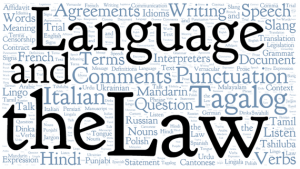
Bangladesh Foreign Direct Investment Statistics
Bangladesh Foreign Direct Investment Statistics https://www.youtube.com/shorts/nCPtomgfI18 Introduction Over the past decade, Bangladesh has emerged as one of the most attractive
 Publishes by The Daily Star on January 06, 2007 (Main Link)
Barrister M. Omar Bin Harun Khan
The whole legal process is inherently tied up with language. The popular image of law is one that emphasises the oral element of legal tradition, that is, the process of argumentation before a court of law. Even the reality, which for most practising lawyers is rather more non-poetic than the way envisaged in the television or cinema, is still a world in which legal documents fill up much of the day. ‘Words’ thus dominate in the legal landscape.
It is widely recognised that there is a substantial gap between ‘legal’ and ‘everyday’ language. In some respects, that gap is narrowing as lawyers are coming to use more naturalistic everyday language, but the continued relevance of old status and precedents means that what are really archaic forms of language are still very much in use in the legal arena, though it is to be said that lawyers are not wholly innocent in the perpetuation of this gap. The law has always tended to be a conservative institution, and the traditional usage of legal jargons has often been presented by some as part of the attraction or mystique of law.
This existence of a ‘distinct legal language’ has wide social effects. The extent to which law relies upon its own language is a very basic indication of the closed nature of legal argument. The need to develop the ‘specialist’ skills of a lawyer has effect of excluding lay persons, that is, non-lawyers from entering into the legal discourses. This consequently puts a limit upon the ability of citizens to gain access to the justice system, which is actually very much needed. Unless and until we use the simple everyday language in drafting statues, drafting the petitions, formulating the laws, delivering the judgments etc, the aim to achieve ‘access to justice’ for all can in no way be achieved. The special use of certain forms of language also serves to disguise rather than enhance our understanding of the legal system. This reflects what Grossfeld described as ‘law as camouflage’ (1990: 47)!
The facet of language not only creates difficulties for lay persons, but also for lawyers outside that very legal system. Hence, legal language is both an important symbol of the power of law itself to define, deliberately or otherwise, who may exercise legal rights, and to disguise the uses of law by those within the system from those outside.
Turning to a different aspect, which has nothing to do with the type of language used in the legal matters, whether ‘specialised’ or ‘everyday’, we should focus on the important aspect of the use of language in describing the facts. Facts in a case need to be described — which of course, requires language. Linguistic differences can be said to affect what had happened in the reality. In the legal environment, the ability of a witness to communicate his/her testimony will be of great importance, because it is the act of communication which creates the facts of the case. Variations in the presentations made by the witnesses can have a dramatic effect on the court’s perception of the witness’s credibility and more importantly on the court’s structuring of the facts.
In the similar vein, the ability of a lawyer to describe the facts and laws also plays a vital role in the Court’s understanding of the facts of the case and thereby has a very close and direct connection with the judgement to be delivered in the case. The linguistic art of a lawyer is considered to be one of the most important factors behind the success or failure of a lawyer along with the depth of his/her legal knowledge. The variation in the presentations of law and facts by the equally wise lawyers render them unequally successful.
Language plays the predominant role in interpreting the statutes. The Parliament finishes its job merely by the enactment of statutes and then it is the courts and the lawyers who take the lead. In most of the cases, the meanings of various words and terminology are defined in the very statutes themselves. Furthermore, the General Clauses Act 1897 comes into rescuing the court, when the statute contains no definition of a particular word used therein. Despite all these, the law is not always what the Parliament wanted it to be, but very often how it has been interpreted by the courts with the helps of the lawyers’ charismatic use of language. If the legal system of a country is based on common law, then the statutory interpretation becomes more important. The courts mostly through their judgements offer the interpretations, as it is not always a common scenario that the statute is defining most of the words used therein. The interpretation so given by the courts then become binding upon the future courts following the doctrine of binding precedents.
It is not an over-statement to say that law is nothing but the linguistic interpretation of some provisions. Laws can be given different shapes based on the language used to describe it. The law means ‘the law’, how it is interpreted in the courts by using the art of interoperation. The relationship between law and language is indivisible and hence the need to use the proper language is undeniable.
Publishes by The Daily Star on January 06, 2007 (Main Link)
Barrister M. Omar Bin Harun Khan
The whole legal process is inherently tied up with language. The popular image of law is one that emphasises the oral element of legal tradition, that is, the process of argumentation before a court of law. Even the reality, which for most practising lawyers is rather more non-poetic than the way envisaged in the television or cinema, is still a world in which legal documents fill up much of the day. ‘Words’ thus dominate in the legal landscape.
It is widely recognised that there is a substantial gap between ‘legal’ and ‘everyday’ language. In some respects, that gap is narrowing as lawyers are coming to use more naturalistic everyday language, but the continued relevance of old status and precedents means that what are really archaic forms of language are still very much in use in the legal arena, though it is to be said that lawyers are not wholly innocent in the perpetuation of this gap. The law has always tended to be a conservative institution, and the traditional usage of legal jargons has often been presented by some as part of the attraction or mystique of law.
This existence of a ‘distinct legal language’ has wide social effects. The extent to which law relies upon its own language is a very basic indication of the closed nature of legal argument. The need to develop the ‘specialist’ skills of a lawyer has effect of excluding lay persons, that is, non-lawyers from entering into the legal discourses. This consequently puts a limit upon the ability of citizens to gain access to the justice system, which is actually very much needed. Unless and until we use the simple everyday language in drafting statues, drafting the petitions, formulating the laws, delivering the judgments etc, the aim to achieve ‘access to justice’ for all can in no way be achieved. The special use of certain forms of language also serves to disguise rather than enhance our understanding of the legal system. This reflects what Grossfeld described as ‘law as camouflage’ (1990: 47)!
The facet of language not only creates difficulties for lay persons, but also for lawyers outside that very legal system. Hence, legal language is both an important symbol of the power of law itself to define, deliberately or otherwise, who may exercise legal rights, and to disguise the uses of law by those within the system from those outside.
Turning to a different aspect, which has nothing to do with the type of language used in the legal matters, whether ‘specialised’ or ‘everyday’, we should focus on the important aspect of the use of language in describing the facts. Facts in a case need to be described — which of course, requires language. Linguistic differences can be said to affect what had happened in the reality. In the legal environment, the ability of a witness to communicate his/her testimony will be of great importance, because it is the act of communication which creates the facts of the case. Variations in the presentations made by the witnesses can have a dramatic effect on the court’s perception of the witness’s credibility and more importantly on the court’s structuring of the facts.
In the similar vein, the ability of a lawyer to describe the facts and laws also plays a vital role in the Court’s understanding of the facts of the case and thereby has a very close and direct connection with the judgement to be delivered in the case. The linguistic art of a lawyer is considered to be one of the most important factors behind the success or failure of a lawyer along with the depth of his/her legal knowledge. The variation in the presentations of law and facts by the equally wise lawyers render them unequally successful.
Language plays the predominant role in interpreting the statutes. The Parliament finishes its job merely by the enactment of statutes and then it is the courts and the lawyers who take the lead. In most of the cases, the meanings of various words and terminology are defined in the very statutes themselves. Furthermore, the General Clauses Act 1897 comes into rescuing the court, when the statute contains no definition of a particular word used therein. Despite all these, the law is not always what the Parliament wanted it to be, but very often how it has been interpreted by the courts with the helps of the lawyers’ charismatic use of language. If the legal system of a country is based on common law, then the statutory interpretation becomes more important. The courts mostly through their judgements offer the interpretations, as it is not always a common scenario that the statute is defining most of the words used therein. The interpretation so given by the courts then become binding upon the future courts following the doctrine of binding precedents.
It is not an over-statement to say that law is nothing but the linguistic interpretation of some provisions. Laws can be given different shapes based on the language used to describe it. The law means ‘the law’, how it is interpreted in the courts by using the art of interoperation. The relationship between law and language is indivisible and hence the need to use the proper language is undeniable.
The author is a practicing Barrister and a part-time lecturer in London College of Legal Studies (LCLS) and British School of Law (BSL).
Law with language, language and law, connection between law and language.

Bangladesh Foreign Direct Investment Statistics https://www.youtube.com/shorts/nCPtomgfI18 Introduction Over the past decade, Bangladesh has emerged as one of the most attractive

এক বোন স্বাক্ষর না দিয়ে ব্ল্যাকমেল করছে Published by Prothom Alo | September 25, 2024 (Link Here) প্রশ্ন: আমি মা–বাবার একমাত্র

দুই পক্ষ গুরুত্ব না দেওয়ায় এখন পর্যন্ত আমাদের কাবিন করা হয়নি Published by Prothom Alo | September 18, 2024 (Link

সিডওর পূর্ণাঙ্গ বাস্তবায়ন হয়নি ৪০ বছরেও Published by Protidiner Bangladesh | September 03, 2024 (Link Here) ‘জাতিসংঘের ‘নারীর প্রতি সব

‘সমাজে ভিকটিম ব্লেইমের সমস্যা প্রকট’ Published by Risingbd | March 08, 2024; (Link Here) Victim blame in society ব্যারিস্টার মিতি
Drop Your Queries

Dhaka Office
Chattogram Office
Dhaka Office Map
Chattogram Office Map